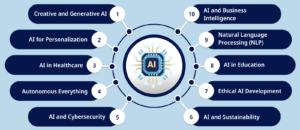You probably hear “AI” everywhere: headlines, our phones, at work. But when you pause and ask “What is artificial intelligence?”—do you always get a clear answer? Not usually. Let’s talk about AI in a way that feels grounded. By the end, I hope you’ll walk away knowing what AI actually is, what generative AI means, what AI can do today, the risks, and where we’re headed.
What Does “AI” Even Mean?
AI stands for Artificial Intelligence. That’s the short way to say machines doing things that usually need human thinking—learning, recognizing, deciding. When someone says “what does AI stand for?”, it’s this basic idea.
But there are shades:
- Narrow AI – like a calculator, or a spam filter, or voice assistants like Siri. It’s good at one thing.
- General AI – a more ambitious idea: imagine a smart entity that can learn nearly anything humans can. We’re not there yet.
What Is AI & What Is Generative AI?
If “what is AI?” feels like a big umbrella, what is generative AI is one of its most buzzing parts. Generative AI = tools that create content: stories, images, video, music, even code. Think ChatGPT or image-creating tools.
For example: a small business owner used a generative AI tool to write product descriptions. It saved hours. And another person used a generative model to create dozens of social media image ideas in a few minutes—something that would’ve taken a week before.
What Can AI Do Right Now?
AI isn’t just in labs or sci-fi. It’s in your life already. Here are real things it’s doing:
- Chatbots that answer your queries at night when customer support is offline.
- Netflix recommending a show you end up loving because it “learned” what you like.
- AI helping doctors by looking at X-rays or scans—spotting things faster.
- Schools using AI to personalize learning—giving you material based on how you learn.
According to 2025 stats, 78% of companies now use AI somewhere in their operations. Generative AI is especially hot: many businesses are using it for content, customer support, marketing, etc.

Benefits: What’s To Gain
AI brings plenty of upsides. When used well, it can:
- Save time: automate routine tasks so you can focus on stuff that needs humans.
- Help decision-making: analyzing data far faster, spotting patterns, helping you avoid mistakes.
- Provide personalization: someone browsing a store may see products that match their taste.
- Boost creativity: tools helping people generate ideas, graphics, or drafts they can refine.
- Expand reach: small teams using AI can do things they couldn’t otherwise afford or hire for.
Real Challenges: Things We Must Think About
It’s not all sunshine. There are real obstacles & risks:
- Bias & fairness
AI learns from our data—which is messy, imperfect. If your data has bias, your AI might too. - Privacy
Collecting lots of personal info comes with big responsibility. Data leaks, misuse—they’re real concerns. - Transparency (“How did it decide that?”)
Some AI decisions are a black box. It can be hard to explain why an AI made a certain recommendation. - Jobs & inequality
Some roles might get automated. Some people benefit more than others. We need to make sure everyone gets a fair shot. - Greener/n Environmental concerns
AI models need energy. Training them, running them—these use power. We must ask: is this sustainable?
Recent studies confirm many organizations agree: AI helps a lot, but many also say lack of expertise, ethics, and oversight are top constraints.
The Future: What’s Coming
If today’s AI feels impressive, the coming years could feel almost uncanny.
- Models will get better at context: understanding tone, mood, or long conversations.
- More background agents: AI that quietly assists you—scheduling, summarizing, reminding—like a smart helper in your daily apps.
- Smarter adoption in business sectors: healthcare diagnoses, education, customer service, manufacturing.
- But also tighter regulation: people are calling for laws and guidelines so AI doesn’t run amok.
AI is moving fast. In 2025, global AI market value sits somewhere over $240-$250 billion, and generative AI use is bursting upward. Many companies aren’t “trying out” AI anymore—they’re using it in production.
What You Can Do: Stay Ahead Without Getting Overwhelmed
If this all feels exciting and a bit overwhelming, here’s how to engage with AI in a way that’s smart:
- Try a small tool or project. Maybe use an AI writing assistant, or let an AI help with image ideas.
- Always review AI output. Let it help—but you still decide the final.
- Focus on ethics: be mindful of biased data, privacy, people impacted.
- Keep learning. Join communities, read about AI, see how people use it.
- Adapt. As AI changes, you’ll need to tweak how you use it.
Final Thoughts
If you ever wonder “What is artificial intelligence?”, remember: it’s less about replacing us and more about amplifying us. AI is strongest when it augments human capability—not tries to replace it.
We’re in a moment where AI can unlock real change—for businesses, for healing, for creativity. But what we build—and how responsibly we build it—matters just as much as what we can build.
I hope this makes “AI” feel less scary, more usable—something you can understand, experiment with, and shape for better. Whenever you’re ready, try something small. You don’t need everything figured out. Just start.